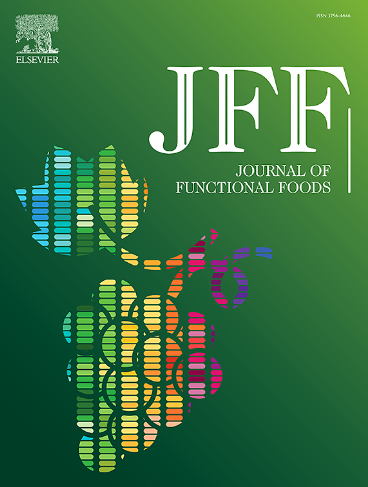通过Cu2+配位调节罗非鱼鳞片明胶水解产物的肽自组装模式:表征、鉴定和抗氧化评价
IF 3.8
2区 农林科学
Q2 FOOD SCIENCE & TECHNOLOGY
引用次数: 0
摘要
我们利用秀丽隐杆线虫研究了罗非鱼鳞片明胶水解物通过Cu2+配位的自组装模式及其在Cu2+诱导的氧化应激下的体内抗氧化特性。使用两种处理方法(Alcalase®,Alc;和 Alcalase® 后加 Flavourzyme®,Alc+Flav)制备完整和≤1 kDa 的水解物。Cu2+ 配位后,所有水解物的纤度和表面疏水性都降低了,这表明β-片状结构发生了退化,并形成了无定形的聚集体。流变学研究证实,在 Cu2+ 配位后,所产生的超分子组装体的结构和机械性能是可调的。由于 Cu2+ 的螯合和自组装特性,Alc 水解产物中的多肽通过 Cu2+ 配位显著降低了内源性 ROS 水平,从而延长了秀丽隐杆线虫的寿命。这些结果为研究 Cu2+ 配位对蠕虫体内多肽自组装和 Cu2+ 诱导的氧化作用的影响提供了有价值的见解,并为食品自组装多肽在生物材料和营养保健品中的应用提供了前景。本文章由计算机程序翻译,如有差异,请以英文原文为准。

Tuning peptide self-assembly patterns in Tilapia scale gelatin hydrolysates through Cu2+ coordination: Characterization, identification and antioxidant evaluation
We investigated the self-assembly pattern of Tilapia scale gelatin hydrolysates through Cu2+ coordination and their in vivo antioxidant properties by Cu2+-induced oxidative stress using the Caenorhabditis elegans. Two treatments (Alcalase®, Alc; and Alcalase® followed by Flavourzyme®, Alc+Flav) were used to prepare whole and ≤ 1 kDa hydrolysates. Upon Cu2+ coordination, the fibrillation and surface hydrophobicity of all hydrolysates decreased, suggesting a degradation of β-sheet structures and the formation of amorphous aggregates. Rheological studies confirmed that the structural and mechanical properties of the resulting supramolecular assemblies are tunable after Cu2+ coordination. Due to the Cu2+-chelating and self-assembly properties, peptides present in the Alc hydrolysate significantly reduced endogenous ROS levels through Cu2+ coordination, thereby extending the lifespan of C. elegans. The results provide valuable insights into the influence of Cu2+ coordination on the progression of peptide self-assembly and Cu2+-induced oxidation in worms and prospects for food self-assembled peptides in biomaterial and nutraceutical applications.
求助全文
通过发布文献求助,成功后即可免费获取论文全文。
去求助
来源期刊

Journal of Functional Foods
FOOD SCIENCE & TECHNOLOGY-
CiteScore
9.60
自引率
1.80%
发文量
428
审稿时长
76 days
期刊介绍:
Journal of Functional Foods continues with the same aims and scope, editorial team, submission system and rigorous peer review. We give authors the possibility to publish their top-quality papers in a well-established leading journal in the food and nutrition fields. The Journal will keep its rigorous criteria to screen high impact research addressing relevant scientific topics and performed by sound methodologies.
The Journal of Functional Foods aims to bring together the results of fundamental and applied research into healthy foods and biologically active food ingredients.
The Journal is centered in the specific area at the boundaries among food technology, nutrition and health welcoming papers having a good interdisciplinary approach. The Journal will cover the fields of plant bioactives; dietary fibre, probiotics; functional lipids; bioactive peptides; vitamins, minerals and botanicals and other dietary supplements. Nutritional and technological aspects related to the development of functional foods and beverages are of core interest to the journal. Experimental works dealing with food digestion, bioavailability of food bioactives and on the mechanisms by which foods and their components are able to modulate physiological parameters connected with disease prevention are of particular interest as well as those dealing with personalized nutrition and nutritional needs in pathological subjects.
 求助内容:
求助内容: 应助结果提醒方式:
应助结果提醒方式:


